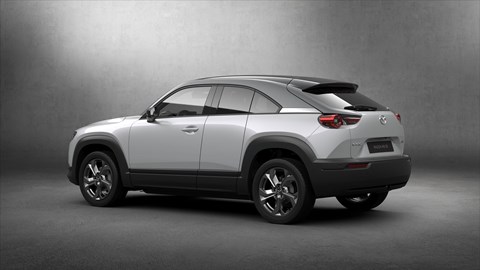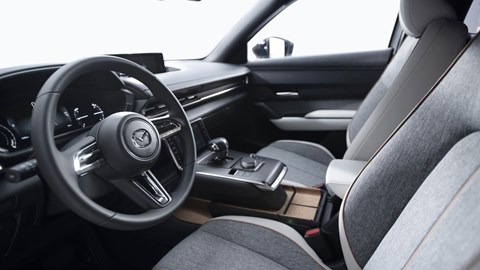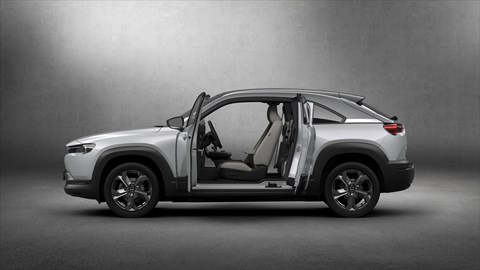► First mass-produced EV from Mazda
► CX-30-sized crossover, RX-8 suicide doors
► First UK sales early 2021 for under £30k
Mazda has started building its first production battery-car, the MX-30 at its Hiroshima factory in Japan. Ordering for the battery-electric crossover is open now, with first UK deliveries expected in early 2021. A compact rotary range extender is in development and will follow a year later. UK pricing is subject to confirmation but should come in under the £30k mark with the government Plug In Car Grant.
Boldly, the MX-30 eschews the current obsession with vast, monolithic batteries and big ranges figure for a more modest and – it says – more sustainable approach. The MX-30 sits on a platform related to that of the conventional CX-30 but optimised around an EV powertrain.
Best electric SUVs and crossovers

The 35.5kWh battery sits under the floor, powering a single e-motor on the front axle and offering a range of around 125 miles between charges on the latest WLTP tests. Contrast that with Hyundai’s Kona Electric, with its 64kWh battery and 245-mile range, though the Mazda will be more affordable and, in theory at least, lighter.
While Mazda is working on a dedicated EV platform with allies Toyota, with energy-dense solid-state batteries on the cards for early 2020s, the MX-30’s architecture is 100% Mazda, and the battery pack a lithium-ion unit.
The marque says that the car wears the MX nameplate because it shares the same pioneering spirit as the MX-5 sports car. And while comparable to the CX-30 in most dimensions, including an overall length of 4395mm and a 2655mm wheelbase, the MX-30 promises to drive with the kind of flair more normally associated with the MX-5.

Project leader Tomiko Takeuchi accepts that many EVs are dynamically uninspiring, but maintains that the MX-30’s modest battery size, the rigidity of its integrated body/battery structure and its low weight, together with the torque vectoring capability of the e-motor, have yielded a nimble, keen-driving crossover. With low-level energy recuperation, brake feel is said to be intuitive and comparable to that of a combustion-engined car.
The exterior design language uses Mazda’s familiar face and elegant, fuss-free surfacing, with an arcing, coupe-like roofline. In time-honoured Mazda style there’s some nicely quirky engineering in the form of the ‘freestyle’ suicide rear doors, last seen on 2003’s RX-8 rotary sports car.
They effectively remove the B-pillar as an obstacle, making for easy access to the rear seats, though rear legroom doesn’t look generous. The cabin features such EV staples as a floating centre console, an unclutter floor and some innovative material usage, notably fibres fashioned from recycled plastic bottles and inlays made of good old-fashioned cork.

The ultra-compact, vibration-free range extender version of the MX-30 will broaden the car beyond urban and suburban commuters, and will form part of Mazda’s multi-powertrain line-up for the coming decade.